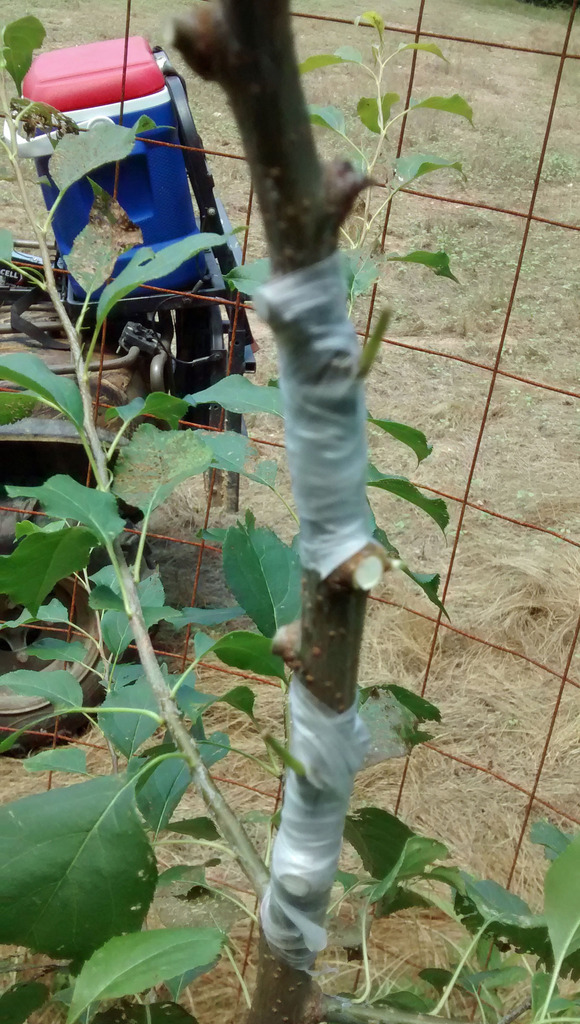I wish I had seen this thread sooner but it was still a great read. I’m not doing anything with figs, but I tried my had at T-budding for the first time last Monday. In my case it was with crabapple. I started crabs from seed last spring, grew them in air pruning containers, and planted them last fall. This spring I tried dormant grafting a few with domestic apple scions. Only one took. I did not remove the foliage and I doubt the young root system had enough energy to support the natural growth already abundant and push the scions. I was probably lucky with the one that took. When you grow crabs from seed, you get a very vigorous tree but there is no guarantee of the fruiting characteristics. So, on Monday I tried my hand at T-Budding. I left one branch to become the central leader the T-Budding fails and left some branches below the graft to support the tree through the summer. Here is a picture
Time will tell how they do. Your thread gave me confidence I was headed in the right direction.
2 Likes
Thanks for the tutorial, fruitnut.
I have a question for you.
I don’t use T-budding much in fig trees. I became accustomed to chip budding and it’s my main technique in figs along with whip and tongue. That is also because most of my grafts are made with cuttings i receive in dormancy - so no slipping of the bark is possible. Nevertheless, i have done some grafting with green wood and chip buddings and the results are good with a very high percentage of takes so i see no reason to change. The only “problem” is if done late (August-September) they will only bud in the following spring.
Have you compared chip budding and t-budding in a way that you can say the later is a better technique in figs and why?
I have also experimented with patch grafting in figs and the results are good with strong unions, but i can’t say if the extra effort is justified.I use a double blade grafting knife to match the patch perfectly.
Some photos.
Chip budding with dormant buds:
Chip budding with green wood (this time i left the petiole covered with parafilm (not really necessary). If the graft takes the petiole falls by itself in 7-10 days. After removing the petiole i usually cover the bud again to avoid drying the bud due to heat.
An example of patch grafting in figs:
9 Likes
Thanks for the tutorial Fruitnut! It gave me the push I needed to give budding another try. I got home a bit early from work tonight I made 17 of them (10 peaches, the rest plums). I did a mix of electrical tape and budding tape (like saran wrap). I’ve never used either of these before, nor budded so early in the season. I’ve normally tried in mid-August or later, so maybe growth has slowed too much by then. Like ahgrower, I don’t think I removed all the wood from the chips in the past, so that could also be part of the problem. I know it isn’t good science to change so many things at once, but I’ve had such dismal results that I just want something to work. Once I have that, I’ll do more tests to see which factor enabled it. 
5 Likes
This is about 2-3 weeks after budding this year.
4 Likes
Oops just realized these are chip buds! The branch was not thick enough to take in the bud inside the flap of a T bud.
2 Likes
Maybe I missed it but what about timing? Can I t-bud now? Apples?
If the tree is growing vigorously, you can T bud. Better when temperatures are hot. Water well before you do it. The bark should be slipping.
Here are some non-traditional T-buds I did. I say non-traditional because mid-spring is not the usual time for T-budding and I also put them in spots where they didn’t have apical shoots above them. They have started growing already which is what I wanted. T-budded on 5/24/2016.
Liberty bud on an extra and somewhat neglected G.969 rootstock.
Williams’ Pride on Zestar for a double variety August tree.
3 Likes
Maybe time of year and not removing the wood from the bud were holding me back. I think I may have a few takes.
Here’s one which looks good (a plum). I cut off the branch past a series of buds, so hopefully at least one or two of them will take.
I made a bunch more buds today, many of them T-Buds. I think I’ve tried it before, but for whatever reason I had remembered that it was hard and I never tried again. This time it seemed pretty easy to make things fit (hopefully that will translate into takes).
I did most permutations of chips and T’s, onto old and new wood, using elastics and budding tape. By the end, I found myself doing more T’s than chips, so it was definitely feeling better.
How do Chip vs T buds generally compare in terms of take rate?
4 Likes
Looks like you’ll tell us. 
This whole thread has been inspiring. Thanks to all who took the time to post pictures.
2 Likes
Yes, but I was hoping for an answer that isn’t quite so impacted by my rough technique. Something of a target, by which I can gauge how much work I have to do.
For example, I’d say that for spring grafting apples and pears (cleft, with reasonable sized scions and established stock) a good target is 95%, 85-90% for plums, 60-70% for apricots (more picky based on temp), etc. I know this is always impacted by the grafter and the local conditions, but a general expectation is still useful.
2 Likes
I’m curious which method was easier to do.
I think in terms of actual effort they are similar- there is a bit more cutting and peeling with the T, but it is easier to tie up, while the chip is a bit of a pain to hold in place while binding. The T felt like it could have a better take rate, as they look very neat and I think the construction would allow less exposure to air and a tighter hold. I’m anxious to see if reality agrees with that guess.
Bob,
If you start at the top and use parafilm, the chip is very easy to tie up. If you start at the bottom and use force it tends to slip and goes out of position.
For me T-buds tend to fail more in the long run after you remove the tape or parafilm.
They take but end up drying more with heat, because they are more exposed - the “flaps” of the incision often “open” with heat and the bud suffers more. A chip has more wood and, to me, resist better (but you have to protect it well with parafilm until it takes). The chips can even appear to dry up but tend to surprise us next spring (T-buds also do that but with less frequency).
Nevertheless, this observations are somewhat dependent on the type of fruit tree you are grafting. It can change a bit if we are talking about peaches, kiwis, plums, pistachio or fig trees (chips are way more successful than t-buds with figs or kiwis, for instance)
A few photos…
T-Bud Peach
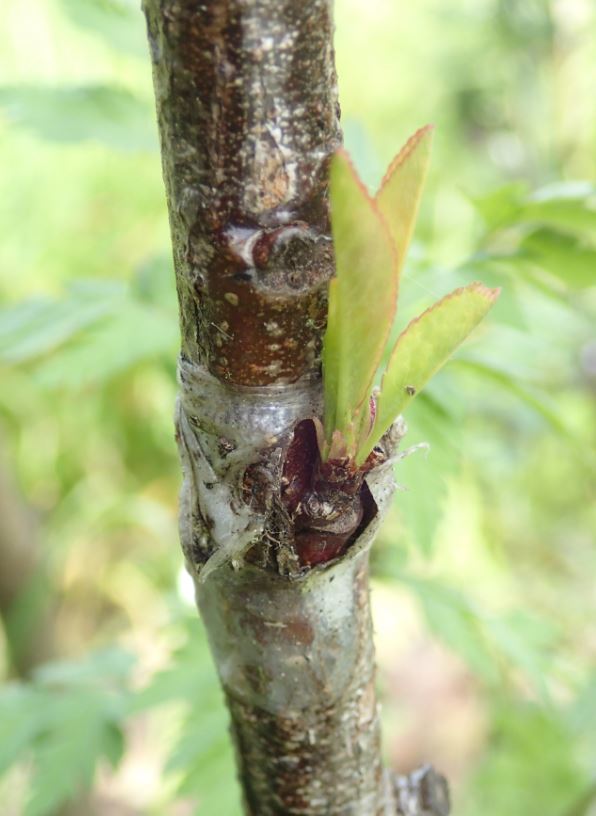
T-Bud Peach - notice the effect of heat on the “flaps” (no problem with this one, but some may dry up)
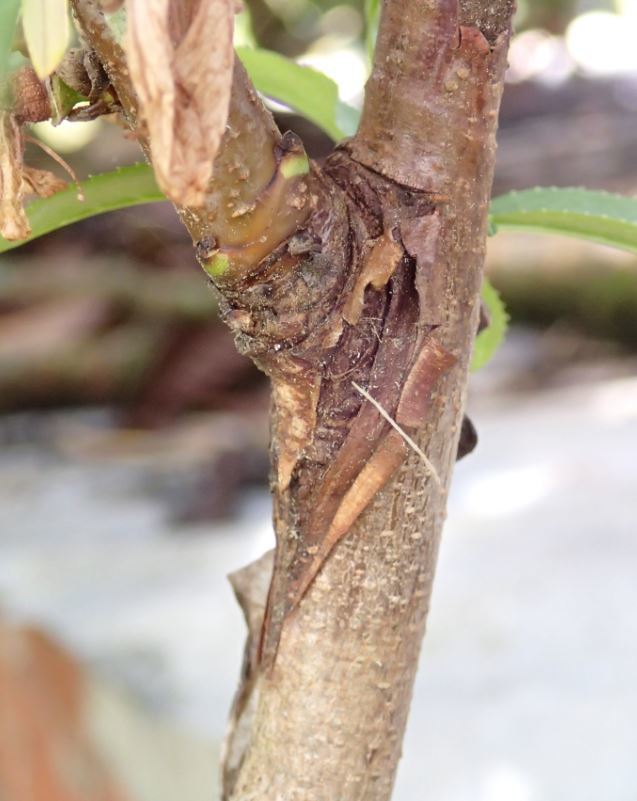
Chip - Peach
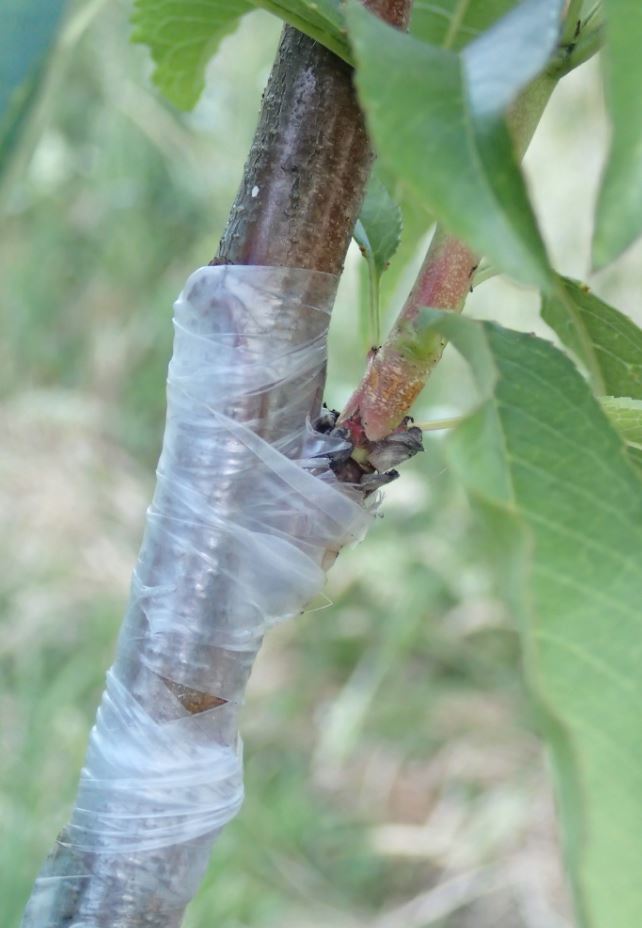
Chip - Peach - after removing the parafilm it resist better the heat (more wood instead of a thin skin). The “underflap” may suffer a bit (thinner) but it usually doesn’t affect the success of the chip.
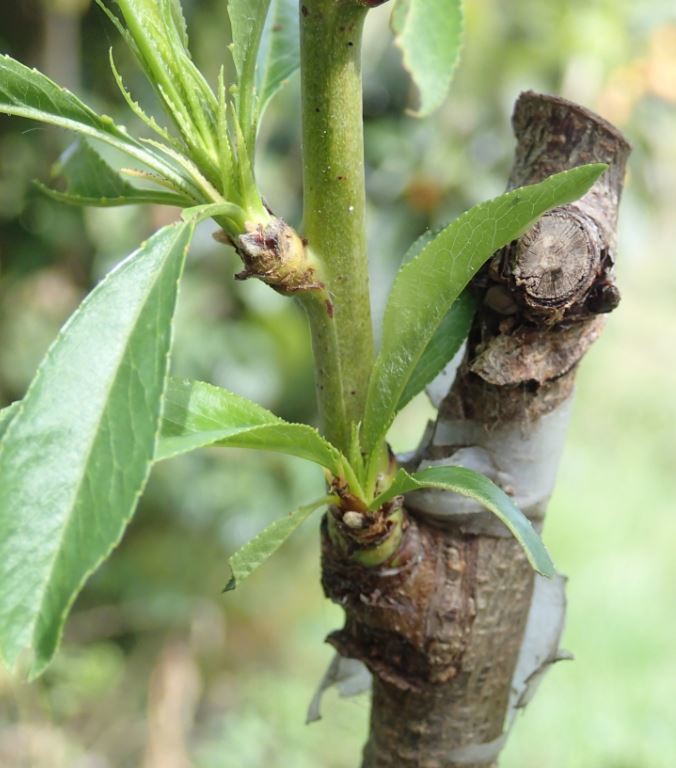
Chip Kiwi (high success rate)
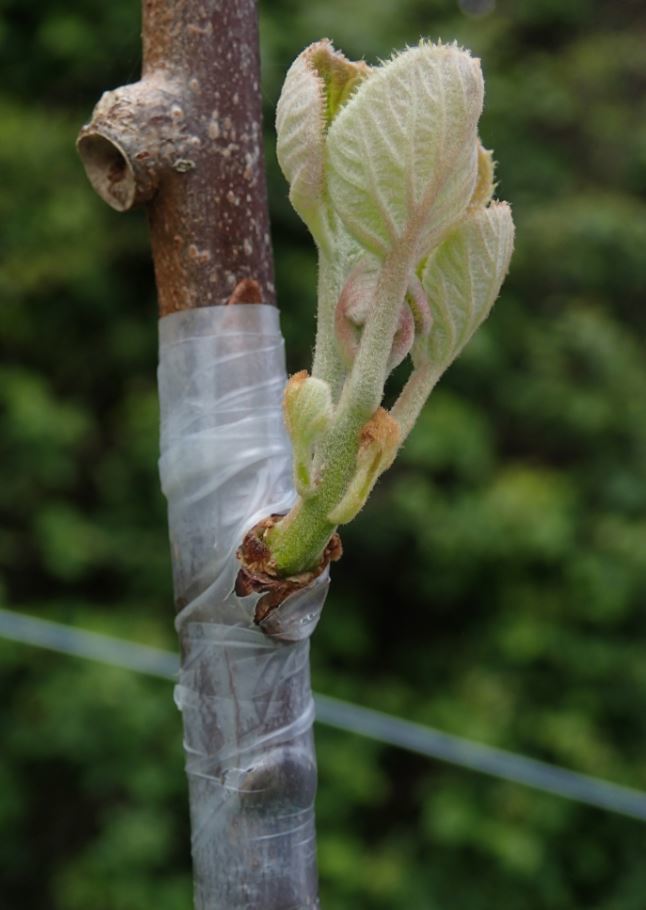
Chip Pistachio (high success rate)
Dormant chips and t-bus - bud break next spring
Chip - Fig Tree - almost one year to bud break. Most T-buds would dry up.

T-Bud - Peach - bud break next spring - notice the “opened” flaps. For me, it’s not so neat, ends up more exposed to elements and some may not succeed.
7 Likes
Nice review and great pictures. Very helpful. Thanks.
You are welcome, Anne.
I have to notice that, in a few years, the t-buds and the chip-buds that were successful will be hard to tell apart, so the end result is similar.
I am referring, essentially, to percentage of takes in less than ideal conditions (too humid, too hot and so on). I am noticing that the t-bud in those situations and in some types of fruits can be more fragile in the early stages or, when done late in the season, they have to endure a harsh winter during the several months of dormancy until next spring.
2 Likes
Fruitnut,
Think I will try to regraft some pears that got broke off in a storm using t-buds. The storm happened fairly late in the year after the grafts had taken and it was to warm to try and whip graft again. The t-bud might be a great solution to that problem. It’s close to 100 here now but the trees are growing. I feel a bit stupid grafting when it’s that warm but I will give it a try in the next week or so.
If the bark is slipping on the stock T buds have a good chance of taking. The real key is that the bud be cleanly and clearly under both flaps of the T and flat against the cambium of the stock. Do that and the bud should heal in.
We are at that point where forcing the buds might be an issue. I’d probably favor trying to force any buds that look good after two weeks. My experience of holding T buds over winter isn’t good. And if you are going to wait that long to force the bud you might as well just regraft in spring.
You might also want to protect any exposed stock or bud and any subsequent growth from the worst of the heat if possible. Paper bag or tinfoil.
3 Likes
Thanks fruitnut I will make it a priority to do a few today. I have an unidentified pear that’s scions are very easy to graft so I tried some buds from that one. This is what I did first and cut a couple of non dormant buds.
Next I prepared the rootstock by cutting a T as you instructed
Peeled the T I cut with the razor back a bit and inserted the bud
I left all the wood behind from the bud
Taped it up tight.
Should I wrap the graft area in parafilm? I did wrap the area with parafilm it made sense to me to do it.
4 Likes
I tried forcing one of my T buds this year. It looks to be a success!
6 Likes
